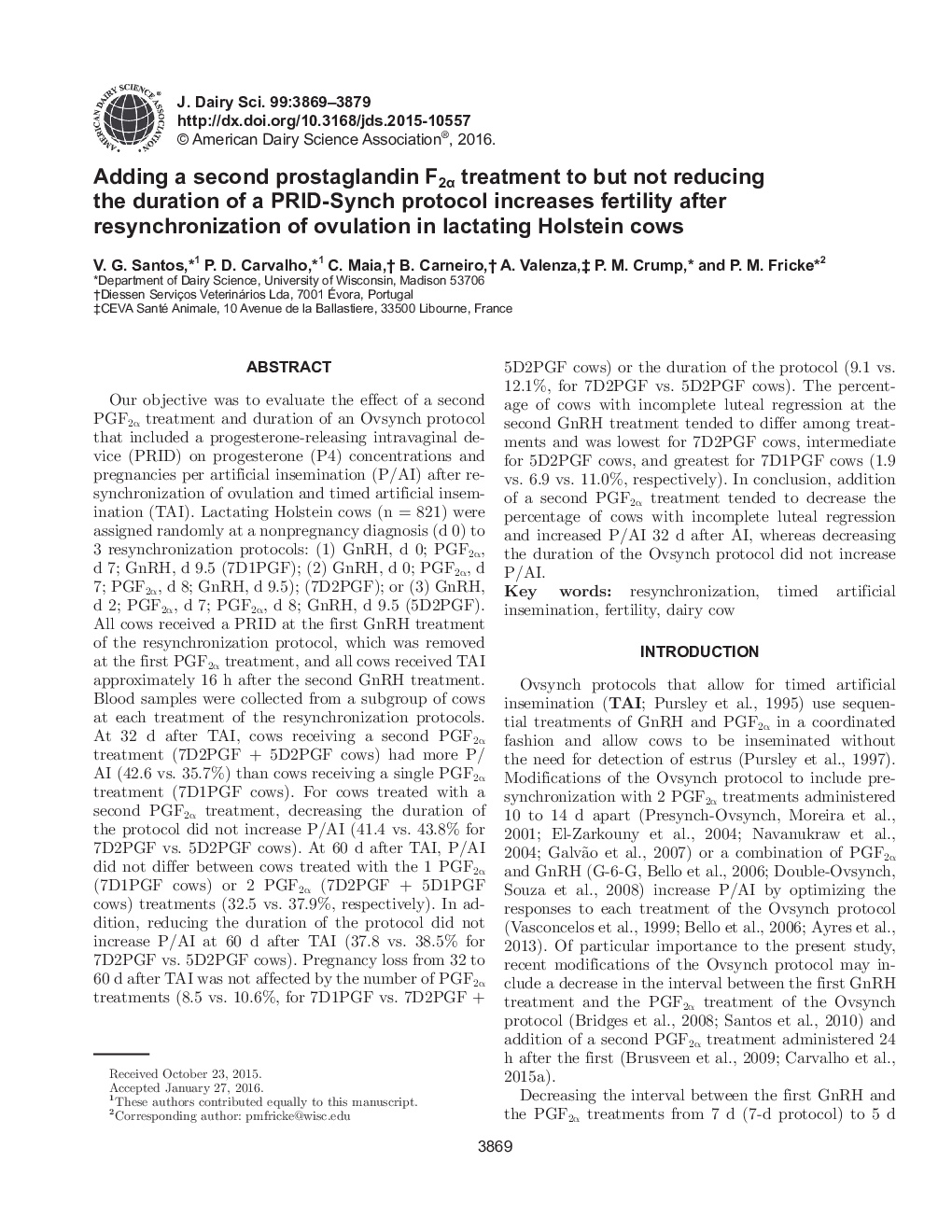| کد مقاله | کد نشریه | سال انتشار | مقاله انگلیسی | نسخه تمام متن |
|---|---|---|---|---|
| 10973779 | 1108018 | 2016 | 11 صفحه PDF | دانلود رایگان |
عنوان انگلیسی مقاله ISI
Adding a second prostaglandin F2α treatment to but not reducing the duration of a PRID-Synch protocol increases fertility after resynchronization of ovulation in lactating Holstein cows
دانلود مقاله + سفارش ترجمه
دانلود مقاله ISI انگلیسی
رایگان برای ایرانیان
کلمات کلیدی
موضوعات مرتبط
علوم زیستی و بیوفناوری
علوم کشاورزی و بیولوژیک
علوم دامی و جانورشناسی
پیش نمایش صفحه اول مقاله

چکیده انگلیسی
Our objective was to evaluate the effect of a second PGF2α treatment and duration of an Ovsynch protocol that included a progesterone-releasing intravaginal device (PRID) on progesterone (P4) concentrations and pregnancies per artificial insemination (P/AI) after resynchronization of ovulation and timed artificial insemination (TAI). Lactating Holstein cows (n = 821) were assigned randomly at a nonpregnancy diagnosis (d 0) to 3 resynchronization protocols: (1) GnRH, d 0; PGF2α, d 7; GnRH, d 9.5 (7D1PGF); (2) GnRH, d 0; PGF2α, d 7; PGF2α, d 8; GnRH, d 9.5); (7D2PGF); or (3) GnRH, d 2; PGF2α, d 7; PGF2α, d 8; GnRH, d 9.5 (5D2PGF). All cows received a PRID at the first GnRH treatment of the resynchronization protocol, which was removed at the first PGF2α treatment, and all cows received TAI approximately 16 h after the second GnRH treatment. Blood samples were collected from a subgroup of cows at each treatment of the resynchronization protocols. At 32 d after TAI, cows receiving a second PGF2α treatment (7D2PGF + 5D2PGF cows) had more P/AI (42.6 vs. 35.7%) than cows receiving a single PGF2α treatment (7D1PGF cows). For cows treated with a second PGF2α treatment, decreasing the duration of the protocol did not increase P/AI (41.4 vs. 43.8% for 7D2PGF vs. 5D2PGF cows). At 60 d after TAI, P/AI did not differ between cows treated with the 1 PGF2α (7D1PGF cows) or 2 PGF2α (7D2PGF + 5D1PGF cows) treatments (32.5 vs. 37.9%, respectively). In addition, reducing the duration of the protocol did not increase P/AI at 60 d after TAI (37.8 vs. 38.5% for 7D2PGF vs. 5D2PGF cows). Pregnancy loss from 32 to 60 d after TAI was not affected by the number of PGF2α treatments (8.5 vs. 10.6%, for 7D1PGF vs. 7D2PGF + 5D2PGF cows) or the duration of the protocol (9.1 vs. 12.1%, for 7D2PGF vs. 5D2PGF cows). The percentage of cows with incomplete luteal regression at the second GnRH treatment tended to differ among treatments and was lowest for 7D2PGF cows, intermediate for 5D2PGF cows, and greatest for 7D1PGF cows (1.9 vs. 6.9 vs. 11.0%, respectively). In conclusion, addition of a second PGF2α treatment tended to decrease the percentage of cows with incomplete luteal regression and increased P/AI 32 d after AI, whereas decreasing the duration of the Ovsynch protocol did not increase P/AI.
ناشر
Database: Elsevier - ScienceDirect (ساینس دایرکت)
Journal: Journal of Dairy Science - Volume 99, Issue 5, May 2016, Pages 3869-3879
Journal: Journal of Dairy Science - Volume 99, Issue 5, May 2016, Pages 3869-3879
نویسندگان
V.G. Santos, P.D. Carvalho, C. Maia, B. Carneiro, A. Valenza, P.M. Crump, P.M. Fricke,